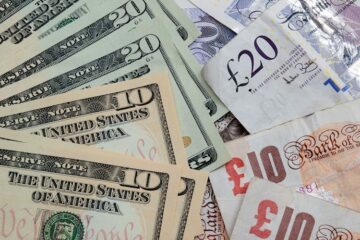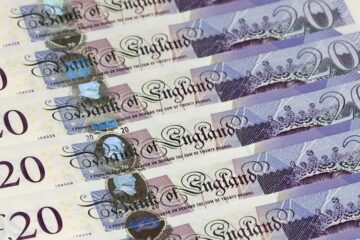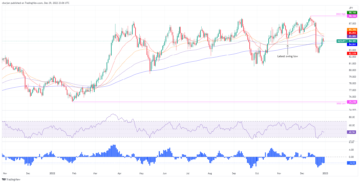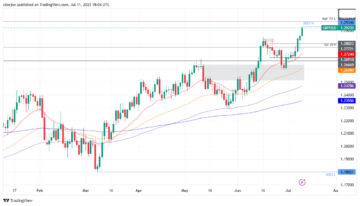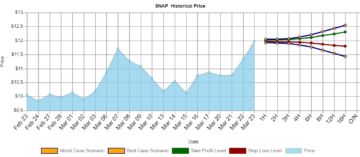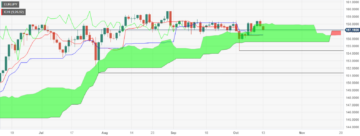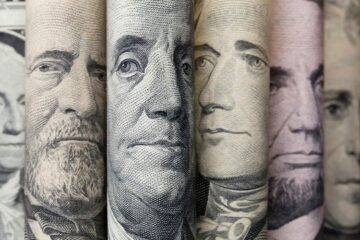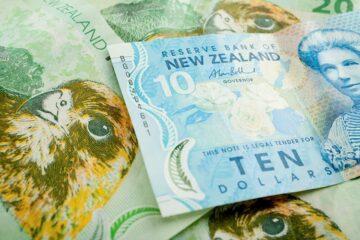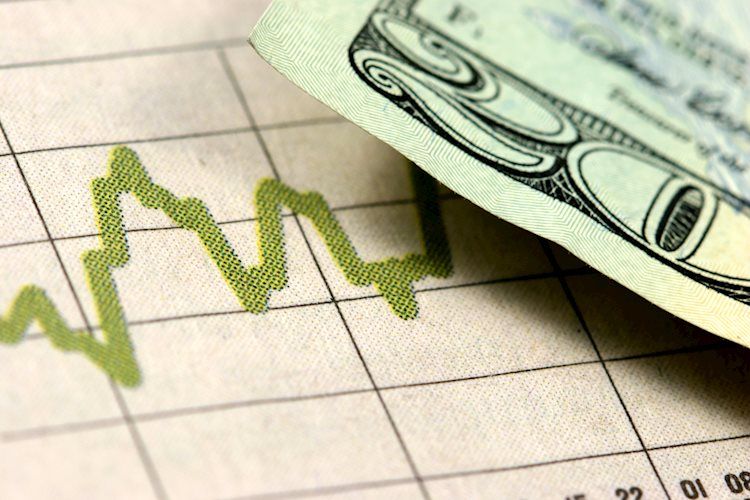
- The US Dollar pulls the sponge over earlier deep red losses after the publication of the Fed Minutes.
- Market sentiment improves after Nvidia earnings beat and a fresh all-time high for the Japanese Nikkei.
- The US Dollar Index falls sharply below 104.00, and bears try to break the heavy-weight 200-day SMA.
The US Dollar (USD) is returning back to flat after a dropkick moment on Thursday after a string of events accelerated a downside move in the US Dollar Index (DXY) overnight. The first decline came on the back of the US Federal Reserve releasing the Minutes of its January meeting. The decrease came even though several participants in the Federal Open Market Committee (FOMC) expressed their concerns about cutting rates too quickly, having learned their lessons from the former policy mistake made in the 1980s by Fed Chairman Paul Volcker. With the DXY hammered, a second selling wave for the Greenback took place after Nvidia posted jawbreaking earnings, spilling the upbeat market mood into Asia, where the Japanese Nikkei hit all-time highs.
On the economic data front, a very chunky calendar ahead on Thursday with some leading indicators. Apart from upbeat US Jobless Claims, the Purchase Manager Index numbers are not really moving the needle with one upbeat element and another undershooting expectatoins. So the upbeat Jobless data is not seeing follow through.
Daily digest market movers: PMI eases Jobless data
- A chunky calendar is set to kick off near 13:30 GMT:
- The Chicago Fed National Activity Index for January went from 0.02 to -0.3.
- Jobless Claims has been released as well
-
- Initial Claims went from 213,000 to 201,000.
- Continuing Claims went from 1.889 million to 1.862 million.
- S&P Global’s preliminary Purchasing Manager Index numbers for February have been released on time:
- The Services PMI went from 52.5 to 51.3.
- The Manufacturing PMI is seen heading from 50.7 to 51.5.
- Existing Home Sales data for January will come out at 15:00 GMT. Sales are expected to increase from 3.78 million to 3.97 million.
- The Kansas Fed Manufacturing Activity Index for February will be released near 16:00 GMT. The previous print was at -17.
- If Fed watchers are hungry for more, this Thursday will feature no less than four Fed members lined up to speak:
- Fed Vice Chair Philip Jefferson is due to speak at 15:00 GMT.
- Philadelphia Fed President Patrick Harker will take the stage at 20:15 GMT.
- Minneapolis Fed President Neel Kashkari will speak at 22:00 GMT.
- Fed board member Lisa Cook is to close off this Thursday with comments near 22:00 GMT.
- Equities are in the green across the board. The Nikkei has printed new all-time highs earlier this Thursday, and the German Dax shot above 1% at the European opening bell. US equity futures are all in the green, with the Nasdaq flirting with 2% gains ahead of the opening bell.
- The CME Group’s FedWatch Tool is now looking at the March 20 meeting. Expectations for a pause are at 95.5%, while chances of a rate cut stand at 4.5%.
- The benchmark 10-year US Treasury Note trades around 4.3% in the Fed Minutes release aftermath and is continuing to soar ahead of the US opening bell.
US Dollar Index Technical Analysis: All over the place
The US Dollar Index (DXY) retreated below 104.00 overnight. Although concerns amongst Fed members about premature interest-rate cuts is the main takeaway from the Fed Minutes, markets see it as being on track for their June timing for a rate cut. Meanwhile, Nvidia earnings have sparked a wave of risk appetite across the globe, that sentiment is a second driver for an abating Greenback this Thursday. Later today, US PMI numbers could take back some of the recent losses.
To the upside, the 100-day Simple Moving Average (SMA) near 104.98 is the first level to watch as a support that has been turned into a resistance. Should the US Dollar jump to 105.00 on the back of strong PMI numbers, 105.12 is a key level to keep an eye on. One step beyond there comes 105.88, the high of November 2023. Ultimately, 107.20 – the high of 2023 – could even come back into scope, but that would be when markets reprice the timing of a Fed rate cut again, delaying it to the last quarter of 2024.
The 200-day Simple Moving Average at 103.72 has been broken and should see more US Dollar bears flock in to trade the break for a weaker US Dollar. The 200-day SMA should not let go that easily, so a small retreat back to that level could be more than granted. Ultimately, it will lose its force with the ongoing selling pressure and could fall to 103.16 at the 55-day SMA.
Central banks FAQs
Central Banks have a key mandate which is making sure that there is price stability in a country or region. Economies are constantly facing inflation or deflation when prices for certain goods and services are fluctuating. Constant rising prices for the same goods means inflation, constant lowered prices for the same goods means deflation. It is the task of the central bank to keep the demand in line by tweaking its policy rate. For the biggest central banks like the US Federal Reserve (Fed), the European Central Bank (ECB) or the Bank of England (BoE), the mandate is to keep inflation close to 2%.
A central bank has one important tool at its disposal to get inflation higher or lower, and that is by tweaking its benchmark policy rate, commonly known as interest rate. On pre-communicated moments, the central bank will issue a statement with its policy rate and provide additional reasoning on why it is either remaining or changing (cutting or hiking) it. Local banks will adjust their savings and lending rates accordingly, which in turn will make it either harder or easier for people to earn on their savings or for companies to take out loans and make investments in their businesses. When the central bank hikes interest rates substantially, this is called monetary tightening. When it is cutting its benchmark rate, it is called monetary easing.
A central bank is often politically independent. Members of the central bank policy board are passing through a series of panels and hearings before being appointed to a policy board seat. Each member in that board often has a certain conviction on how the central bank should control inflation and the subsequent monetary policy. Members that want a very loose monetary policy, with low rates and cheap lending, to boost the economy substantially while being content to see inflation slightly above 2%, are called ‘doves’. Members that rather want to see higher rates to reward savings and want to keep a lit on inflation at all time are called ‘hawks’ and will not rest until inflation is at or just below 2%.
Normally, there is a chairman or president who leads each meeting, needs to create a consensus between the hawks or doves and has his or her final say when it would come down to a vote split to avoid a 50-50 tie on whether the current policy should be adjusted. The chairman will deliver speeches which often can be followed live, where the current monetary stance and outlook is being communicated. A central bank will try to push forward its monetary policy without triggering violent swings in rates, equities, or its currency. All members of the central bank will channel their stance toward the markets in advance of a policy meeting event. A few days before a policy meeting takes place until the new policy has been communicated, members are forbidden to talk publicly. This is called the blackout period.
- SEO Powered Content & PR Distribution. Get Amplified Today.
- PlatoData.Network Vertical Generative Ai. Empower Yourself. Access Here.
- PlatoAiStream. Web3 Intelligence. Knowledge Amplified. Access Here.
- PlatoESG. Carbon, CleanTech, Energy, Environment, Solar, Waste Management. Access Here.
- PlatoHealth. Biotech and Clinical Trials Intelligence. Access Here.
- Source: https://www.fxstreet.com/news/us-dollar-falls-to-three-week-low-as-market-sentiment-improves-202402221230
- :has
- :is
- :not
- :where
- ][p
- $UP
- 00
- 000
- 02
- 1
- 107
- 12
- 13
- 15%
- 16
- 2%
- 20
- 2023
- 2024
- 22
- 30
- 33
- 36
- 4
- 5
- 50
- 51
- 52
- 7
- 72
- 97
- 98
- a
- About
- above
- accelerated
- accordingly
- across
- activity
- Additional
- adjust
- Adjusted
- advance
- After
- aftermath
- again
- ahead
- All
- all-time highs
- Although
- amongst
- an
- analysis
- and
- Animate
- Another
- apart
- appetite
- appointed
- ARE
- around
- AS
- asia
- At
- average
- avoid
- back
- Bank
- Bank of England
- Bank of England (BOE)
- Banks
- BE
- Bears
- beat
- been
- before
- being
- Bell
- below
- Benchmark
- Benchmark Rate
- between
- Beyond
- Biggest
- board
- board member
- BoE
- boost
- Break
- Broken
- businesses
- but
- by
- Calendar
- called
- came
- CAN
- central
- Central Bank
- Central Banks
- certain
- Chair
- chairman
- chances
- changing
- Channel
- cheap
- chicago
- Chicago Fed
- chunky
- claims
- Close
- CME
- come
- comes
- comments
- committee
- commonly
- communicated
- Companies
- Concerns
- Consensus
- constant
- constantly
- content
- continuing
- control
- control inflation
- conviction
- could
- country
- create
- Currency
- Current
- Cut
- cuts
- cutting
- data
- Days
- Decline
- decrease
- deep
- deflation
- deliver
- Demand
- Digest
- disposal
- Dollar
- dollar index
- down
- downside
- driver
- due
- Dxy
- each
- Earlier
- earn
- Earnings
- Eases
- easier
- easily
- easing
- ECB
- Economic
- economies
- economy
- either
- element
- ends
- England
- Equities
- equity
- European
- European Central Bank
- Even
- Event
- events
- expanded
- expectations
- expected
- expressed
- eye
- facing
- Fall
- Falls
- FAQ
- Feature
- February
- Fed
- Fed Chairman
- Fed Minutes
- Federal
- Federal Open Market Committee
- federal reserve
- few
- final
- First
- flat
- follow
- followed
- FOMC
- For
- Force
- Former
- Forward
- four
- fresh
- from
- front
- Futures
- Gains
- German
- get
- globe
- GMT
- Go
- goods
- granted
- Green
- Greenback
- Group’s
- hammered
- harder
- Have
- having
- Heading
- her
- High
- higher
- Highs
- Hikes
- hiking
- his
- Hit
- Home
- How
- HTTPS
- Hungry
- important
- improves
- in
- Increase
- independent
- index
- Indicators
- inflation
- interest
- INTEREST RATE
- Interest Rates
- into
- Investments
- issue
- IT
- ITS
- January
- Japanese
- jobless claims
- jpg
- jump
- june
- just
- Kansas
- Keep
- Key
- kick
- known
- Last
- later
- leading
- Leads
- learned
- lending
- less
- Lessons
- let
- Level
- like
- Line
- lined
- live
- Loans
- local
- LOCAL BANKS
- looking
- lose
- losses
- Low
- low rates
- lower
- lowered
- made
- Main
- make
- Making
- manager
- mandate
- manufacturing
- March
- Market
- Markets
- means
- Meanwhile
- meeting
- member
- Members
- million
- minutes
- mistake
- module
- moment
- Moments
- Monetary
- Monetary Policy
- monetary tightening
- mood
- more
- move
- Movers
- moving
- moving average
- Nasdaq
- National
- Near
- needs
- Neel Kashkari
- New
- new policy
- no
- note
- November
- now
- numbers
- Nvidia
- of
- off
- often
- on
- ONE
- ongoing
- open
- opening
- or
- out
- Outlook
- over
- overnight
- panels
- participants
- Passing
- patrick
- Paul
- pause
- People
- period
- Place
- plato
- Plato Data Intelligence
- PlatoData
- pmi
- policy
- politically
- posted
- preliminary
- Premature
- president
- pressure
- previous
- price
- Prices
- provide
- Publication
- publicly
- Pulls
- purchase
- purchasing
- Push
- Quarter
- quickly
- Rate
- Rates
- rather
- really
- reasoning
- recent
- Red
- region
- release
- released
- releasing
- remaining
- Reserve
- Resistance
- REST
- Retreat
- returning
- Reward
- rising
- Risk
- risk appetite
- sales
- same
- Savings
- say
- scope
- Second
- see
- seeing
- seen
- Selling
- sentiment
- Series
- Services
- set
- several
- shot
- should
- Simple
- slightly
- SMA
- small
- So
- soar
- some
- sparked
- speak
- speeches
- split
- Stability
- Stage
- stance
- stand
- starts
- Statement
- Step
- String
- strong
- subsequent
- substantially
- support
- supportive
- sure
- Swings
- Take
- takes
- Talk
- Task
- Technical
- Technical Analysis
- than
- that
- The
- the Fed
- The US Federal Reserve
- their
- There.
- this
- though?
- Through
- thursday
- TIE
- tightening
- time
- timing
- to
- today
- too
- took
- tool
- toward
- track
- trade
- trades
- treasury
- triggering
- try
- TURN
- Turned
- turns
- tweaking
- Ultimately
- until
- upbeat
- Upside
- us
- US Dollar
- US Dollar Index
- US Federal
- us federal reserve
- US Jobless Claims
- US Treasury
- USD
- very
- vice
- Vote
- want
- was
- Watch
- Wave
- weaker
- went
- when
- whether
- which
- while
- WHO
- why
- will
- with
- without
- would
- zephyrnet

